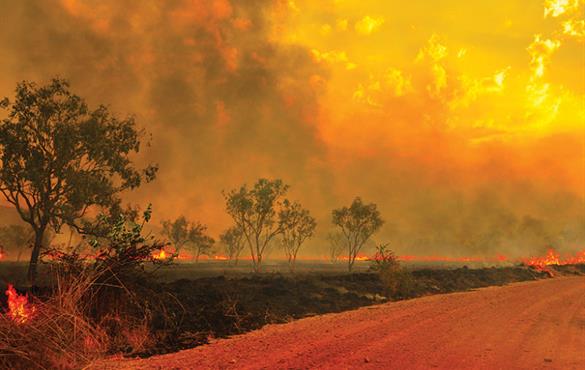Firing up climate models
Scientists are working to incorporate wildfire data into climate models, resolving hindrances related to scale, speed, and the complex feedbacks between the climate and wildfire emissions

Earth is always burning. From 2003 to 2016, more than 13 million fires of various sizes and intensities flamed and smoldered across the planet. The United States alone has averaged nearly 67,000 fires annually in the past decade, with more than 46,000 fires occurring in 2019 as of late November. Worldwide, large expanses of Siberia have been aflame, with the fires sometimes covering areas the size of the state of Massachusetts. In South America, tens of thousands of fires have blazed through the Amazon, the world’s largest tropical rain forest, and thousands more have burned in the Pantanal, the world’s largest tropical wetland. Bushfires rage across the Australian state of New South Wales, lowering air quality in nearby areas to unprecedented levels.
Going Small for Big Understandings
Accurately measuring emissions from fires and understanding how they evolve in the atmosphere are big steps in building global climate models, but they’re only part of the puzzle.
How primary emissions, and the secondary particles into which they evolve, affect atmospheric and climatic processes is another key piece. To understand these effects, Rajan Chakrabarty, an environmental and chemical engineer at Washington University in St. Louis, has gone to the microscopic level. “We study, for example, how the shape, mass, and optical properties of specific emissions change inside fires and then outside them,” Chakrabarty said.
One type of fire emission that Chakrabarty has studied is black carbon, a particulate emission resulting from the incomplete combustion of carbonaceous materials like fossil fuels, agricultural leftovers, and other biomass. These tiny particulates strongly absorb sunlight, thus warming the atmosphere and changing cloud dynamics. Although they are relatively short-lived in the atmosphere, black carbon particles can still travel long distances through the atmosphere and be deposited in snowy or icy regions on land (such as in the Arctic or the Himalaya). In these regions, they can have myriad effects, including reducing the amount of sunlight reflected by snow and ice, and increasing melting, which in turn contribute to climate warming.
Chakrabarty and colleagues were the first to discover that large, open fires, such as wildfires, emit a form of black carbon different from that seen in emissions from automobile exhaust or from domestic cooking or heating. Black carbon in wildfire emissions forms larger aggregates, called percolated aggregates, or PAs, that have significantly different optical properties and absorb more incoming solar radiation of certain wavelengths. “These observations suggest that soot PAs may have…previously unaccounted for impacts on climate forcing,” according to Chakrabarty.
Whereas blazing forest fires emit large amounts of black carbon, smoldering fires, such as those seen when peatlands burn, emit different aerosols and particulates. Chakrabarty and colleagues have shown that peat fires emit mostly brown carbon and almost no black carbon. Unlike black carbon, which absorbs light across the visible spectrum, brown carbon absorbs near-ultraviolet and blue light, reflecting green, yellow, and red wavelengths.
“Initially, people thought that brown carbon particles would act like a mirror, because they reflect some light, and so offset the warming effects of black carbon in the atmosphere,” Chakrabarty said. But his research has shown that brown carbon particles can absorb certain wavelengths of light that contribute to warming more strongly than black carbon particles. “So now we know [that] these particles can actually increase the net warming effects of black carbon.”
Fires, from smoldering peat fires to blazing forest fires to the hazy burnings of farm stubble, are incredibly complex. Researchers are making progress in understanding the behaviors of different kinds of fires, the intricacies and evolution of their emissions, and the interactions of fires with the environment—all knowledge that is vital in improving the accuracy of climate models. There is a long way to go, however, and no time to waste as risks posed by wildfires to communities continue to grow and the climate continues to change. “We need to know these details [related to fires and emissions],” Warneke said, “to make accurate predictions of air quality and [to] model global climate.”
>> Read the full article in Earth and Space Science News
Click on the topics below for more stories in those areas
- Global
- In the media
- Energy, Environmental & Chemical Engineering
- The Institute of Materials Science & Engineering




